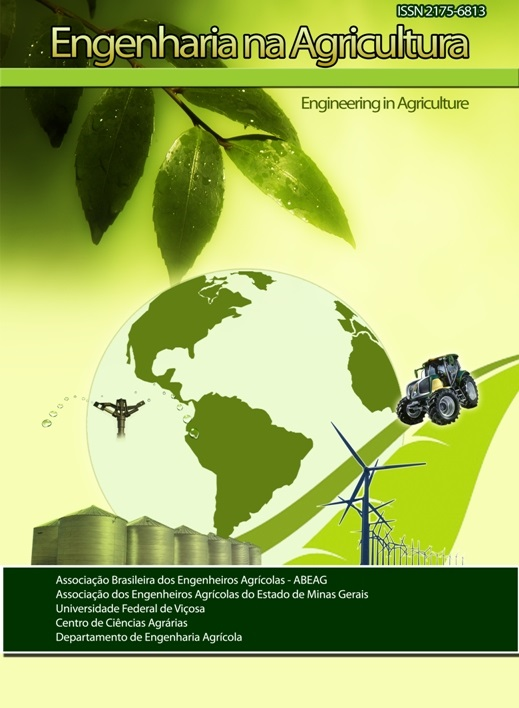Influence of temperature and altitude on the expansion of coffee crops in matas de Minas, Brazil
DOI:
https://doi.org/10.13083/reveng.v28i.6360Palavras-chave:
coffea Arabica, coffee cultivation, modeling, MaxEnt, SIG, species distribution.Resumo
Coffee is among the most significant products in Brazil. Minas Gerais is the largest state producer of Arabica coffee. Coffee activity has excellent growth potential, which justifies the identification of new areas for expansion of the culture. This study aimed to determine factors that affect the spatial distribution of coffee plantations the most, as well as to identify areas with a greater aptitude for its expansion in the region of the Matas de Minas (63 municipalities). The MaxEnt software was used to elaborate a model capable of describing the area with the highest potential for estimating the probability of coffee adequacy. The elaboration of the model considered the records of occurrence, climatic and topographic variables of Matas de Minas, the second largest state producing region. The area under the curve (AUC), the omission rate and the Jackknife test were used for validation and analysis of the model. The model was accurate with an AUC of 0.816 and omission rate of 0.54% for the ‘test’. It was identified that the potential distribution of coffee in Matas de Minas is determined by changes in the annual maximum temperature, although it did not generate a significant gain when omitted, accounting for a considerable loss in the model. However, the most influential variables on the delineation of distribution were, the altitude and the annual average temperature. The most favorable areas for expansion of coffee culture in the Matas de Minas were found in the vicinity of the region of Alto Caparaó.
Abbreviations used: A1 (altitude); A2 (maximum annual temperature); A3 (annual minimum temperature); BIO 1 (annual average temperature 1); BIO 4 (temperature seasonality), BIO 12 (annual precipitation); BIO 15 (precipitation seasonality); csv (comma-separated values); AUC (area under the curve).
Downloads
Referências
ARANDA, Silvia C.; LOBO, Jorge M. How well does presence only based species distribution modelling predict assemblage diversity? A case study of the Tenerife flora. Ecography, v.34, n.1, p.31-38, 2011.
https://doi.org/10.1111/j.1600-0587.2010.06134.x
CAMARGO, M.B.P. The impact of climatic variability and climate change on arabic coffee crop in Brazil. Bragantia, v.69, n.1, p.239-247, 2010. http://dx.doi.org/10.1590/S0006-87052010000100030
COELHO, G.L.N; DE CARVALHO, L.M.T; GOMIDE, L.R. Modelagem preditiva de distribuição de espécies pioneiras no Estado de Minas Gerais. Pesquisa Agropecuária Brasileira, v.51, n.3, p.207-214, 2016.
DOI: 10.1590/S0100-204X2016000300002
CONAB, Companhia Nacional de Abastecimento. Acompanhamento da safra brasileira: café, 4 (4): 1-84, 2017.
ELITH, J.; PHILLIPS S.J.; HASTIE T.; DUDÍK M.; CHEE Y.E., YATES C.J.; A statistical explanation of MaxEnt for ecologists. Diversity and Distributions, 17: 43–57., 2011.
https://doi:10.1111/j.1472-4642.2010.00725.x
Ferreira, W.P., Queiroz, D.M., Silvac, S.A., Tomaz, R.S., Corrêa, P.C. Effects of the Orientation of the Mountainside, Altitude and Varieties on the Quality of the Coffee Beverage from the “Matas de Minas” Region, Brazilian Southeast. American Journal of Plant Sciences, v.7, p.1291-1303, 2016.
http://dx.doi.org/10.4236/ajps.2016.78124
METZ, Charles E. ROC methodology in radiologic imaging. Investigative radiology, v.21, n.9, p.720-733, 1986.
Santana, F.S., De Siqueira, M.F., Saraiva, A.M., & Corrêa, P.L.P. . A reference business process for ecological niche modelling. Ecological informatics, v.3, n.1, p.75-86, 2008.
Santos R.V.M., Vieira H.D., Borem F.M., Prado M.V.B.,. Aplicação de técnicas estatísticas multivariadas em dados de custos da fase de pós-colheita do café. Coffee Science, 12 (2): 223-230, 2017.
Zaidan, Ú.R., Corrêa, P.C., Ferreira, W.P.M., & Cecon, P.R. Ambiente e variedades influenciam a qualidade de cafés das Matas de Minas. Coffee Science, 12 (2): 240-247. 2017.
Downloads
Publicado
Como Citar
Edição
Seção
Licença
Copyright (c) 2020 REVISTA ENGENHARIA NA AGRICULTURA - REVENG

Este trabalho está licenciado sob uma licença Creative Commons Attribution-NonCommercial 4.0 International License.
Autores que publicam nesta revista concordam com os seguintes termos:
O(s) autor(es) autoriza(m) a publicação do texto na da revista;
O(s) autor(es) garantem que a contribuição é original e inédita e que não está em processo de avaliação em outra(s) revista(s);
A revista não se responsabiliza pelas opiniões, ideias e conceitos emitidos nos textos, por serem de inteira responsabilidade de seu(s) autor(es);
É reservado aos editores o direito de proceder a ajustes textuais e de adequação às normas da publicação.
A partir da submissão, o autor estará cedendo integralmente seus direitos patrimoniais da obra à publicação, permanecendo detentor de seus direitos morais (autoria e identificação na obra) e de acordo com a Licença Creative Commons, CC BY-NC.








 Esta obra está licenciada com uma Licença
Esta obra está licenciada com uma Licença 